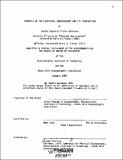| dc.contributor.advisor | Mark Cane, Philip Richardson. | en_US |
| dc.contributor.author | Wacongne, Sophie | en_US |
| dc.contributor.other | Woods Hole Oceanographic Institution. | en_US |
| dc.date.accessioned | 2010-09-14T18:05:30Z | |
| dc.date.available | 2010-09-14T18:05:30Z | |
| dc.date.copyright | 1988 | en_US |
| dc.date.issued | 1988 | en_US |
| dc.identifier.uri | http://hdl.handle.net/1721.1/58533 | |
| dc.description | Thesis (Ph. D.)--Joint Program in Oceanography (Massachusetts Institute of Technology, Dept. of Earth, Atmospheric, and Planetary Sciences; and the Woods Hole Oceanographic Institution), 1988. | en_US |
| dc.description | Includes bibliographical references (v.2, leaves 339-351). | en_US |
| dc.description.abstract | This study focuses on the zonal weakening, eastern termination and seasonal variations of the Atlantic equatorial undercurrent (EUC). The main and most original contribution of the dissertation is a detailed analysis of the Atlantic EUC simulated by Philander and Pacanowski's (1986)general circulation model (GCM), which provides a novel description of the dynamical regimes governing various regions of a nonlinear stratified undercurrent. Only in a narrow deep western region of the simulation does one find an approximately inertial regime corresponding to zonal acceleration. Elsewhere frictional processes cannot be ignored. The bulk of the mid-basin model EUC terminates in the overlying westward surface flow while only a small fraction (the deeper more inertial layers) terminates at the eastern coast. In agreement with observations, a robust feature of the GCM not present in simpler models is the apparent migration of the EUC core from above the thermocline in the west to below it in the east. In the GCM, this happens because the eastward flow is eroded more efficiently by vertical friction above the base of the thermocline than by lateral friction at greater depths. This mechanism is a plausible one for the observed EUC. A scale analysis using a depth scale which decreases with distance eastwards predicts the model zonal transition between western inertial and eastern inertio-frictional regimes. Historical and recent observations and simple models of the equatorial and coastal eastern undercurrents are reviewed, and a new analysis of current measurements in the eastern equatorial Atlantic is presented. Although the measurements are inadequate for definitive conclusions, they suggest that Lukas' (1981) claim of a spring surge of the Pacific EUC to the eastern coast and a seasonal branching of the EUC into a coastal southeastward undercurrent may also hold for the Atlantic Ocean. To improve the agreement between observed and modelled strength of the eastern undercurrent, it is suggested that the eddy coefficient of horizontal mixing should be reduced in future GCM simulations. | en_US |
| dc.description.statementofresponsibility | by Sophie Huguette Claire Wacongne. | en_US |
| dc.format.extent | 2 v. (366 leaves) | en_US |
| dc.language.iso | eng | en_US |
| dc.publisher | Massachusetts Institute of Technology | en_US |
| dc.rights | M.I.T. theses are protected by
copyright. They may be viewed from this source for any purpose, but
reproduction or distribution in any format is prohibited without written
permission. See provided URL for inquiries about permission. | en_US |
| dc.rights.uri | http://dspace.mit.edu/handle/1721.1/7582 | en_US |
| dc.subject | Joint Program in Oceanography. | en_US |
| dc.subject | Earth, Atmospheric, and Planetary Sciences. | en_US |
| dc.subject | Woods Hole Oceanographic Institution. | en_US |
| dc.subject.lcc | GC7.1 | en_US |
| dc.title | Dynamics of the equatorial undercurrent and its determination | en_US |
| dc.title.alternative | Dynamics of the EU and its determination | en_US |
| dc.title.alternative | Equatorial undercurrent and its termination, Dynamics of the | en_US |
| dc.type | Thesis | en_US |
| dc.description.degree | Ph.D. | en_US |
| dc.contributor.department | Joint Program in Oceanography | en_US |
| dc.contributor.department | Woods Hole Oceanographic Institution | en_US |
| dc.contributor.department | Massachusetts Institute of Technology. Department of Earth, Atmospheric, and Planetary Sciences | |
| dc.identifier.oclc | 18613329 | en_US |
